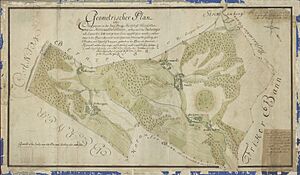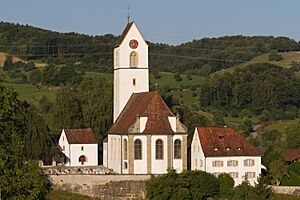Herznach facts for kids
Quick facts for kids
Herznach
|
||
|---|---|---|

Herznach village with the St. Nikolaus Church in foreground
|
||
|
||
| Country | Switzerland | |
| Canton | Aargau | |
| District | Laufenburg | |
| Area | ||
| • Total | 6.28 km2 (2.42 sq mi) | |
| Elevation | 413 m (1,355 ft) | |
| Population
(December 2006)
|
||
| • Total | 1,229 | |
| • Density | 195.70/km2 (506.9/sq mi) | |
| Postal code |
5027
|
|
| Surrounded by | Densbüren, Gipf-Oberfrick, Ueken, Wölflinswil, Zeihen | |
Herznach was a small town, also known as a municipality, in the Laufenburg area of the canton of Aargau in Switzerland. On January 1, 2023, Herznach and another town called Ueken joined together. They are now one new municipality named Herznach-Ueken.
Contents
History of Herznach
People have lived in the Herznach area for a very long time. Graves from the Alamanni era (an ancient Germanic people) have been found here. The first time Herznach was written about was in 1097. It was called Hercenahc back then.
Early Rulers and Castle
A powerful family called von Herznach lived here. They were Ministerialis, which means they were knights who served a lord, even though they weren't completely free. Herznach castle was built on the remains of an even older house from the 7th to 10th centuries.
Herznach and the nearby town of Ueken were first ruled by the Homberger family. Later, in the early 1300s, the Habsburgs (a very important royal family) gained the right to judge serious crimes in Herznach. From 1495 until 1797, Herznach was part of the Austrian area of Rheinfelden. The local community likely managed common lands and some local laws.
Churches and Parishes
The Church of St. Nicholas was first mentioned in 1180. It was probably a church for the Homberger family. Over time, its ownership changed. In 1651, the main part of the church and its tower were made bigger. The choir (the part of the church where the singers sit) was completely rebuilt in 1718-19.
The Chapel of Saint Verena was built in 1516. It was built on the foundations of an even older chapel from the Early and High Middle Ages. Even today, Herznach and Ueken share the same church parish (a church district). In the past, this parish included other villages too.
Becoming Independent and Growing
In 1803, a new law called the Act of Mediation made the Fricktal region (where Herznach is) part of the Canton of Aargau. This made Herznach and Ueken independent towns. By 1811, the two main parts of Herznach, Unterherznach (the church area) and Oberherznach (the mill area), had grown together along the road.
Mining and Industry
People mined for iron ore in Herznach during the Middle Ages and again during World War II. The mine finally closed in 1967. In 1872, a factory opened in Herznach that made thread. Later, in 1918, it started making fabrics. Another factory, built in 1952, made advertising balloons. By the early 2000s, Herznach was a farming community with some homes and two factories.
Geography of Herznach
Herznach covers an area of about 6.28 square kilometers (2.42 square miles). A large part of this land, about 63.2%, is used for farming. Forests cover about 24.5% of the area. Buildings and roads make up about 11.5% of the land. A very small part, 0.3%, is rivers or lakes.
Most of the built-up area is for houses and other buildings (8.1%). Roads and other transport areas make up 2.9%. About 22.5% of the land is covered with thick forests. Another 2.1% has orchards or small groups of trees. For farming, 39.8% of the land is used for growing crops. About 17.4% is used for pastures where animals graze. Another 6.1% is for orchards or vineyards. All the water in Herznach is in rivers and streams.
Herznach is located in the Laufenburg district, in the upper part of the Fricktal (Frick river valley). It sits on an old road that goes over the Staffelegg to Aarau. Herznach is a linear village, meaning it stretches out along a road. Until 1852, a small village called Oberzeihen (now part of Zeihen) was also part of Herznach.
Herznach's Coat of Arms
The blazon (description) of Herznach's coat of arms is: Gules a Pitcher Vert lip dexter and handled Or. This means it shows a green pitcher with a gold handle on a red background. The pitcher is a symbol of Saint Verena, to whom the chapel in Herznach is dedicated.
Population and People
As of 2022, Herznach had a population of 1,647 people. About 9.6% of the people living in Herznach are from other countries. Over ten years (1997–2007), the population grew by about 20.1%. Most people in Herznach (96.5%) speak German. Albanian is the second most common language (1.7%), followed by English (0.5%).
Age Groups in Herznach
In 2008, the population of Herznach was divided into different age groups:
- Children aged 0-9: 160 (12.4%)
- Teenagers aged 10-19: 170 (13.2%)
- Young adults aged 20-29: 167 (12.9%)
- Adults aged 30-39: 172 (13.3%)
- Adults aged 40-49: 211 (16.4%)
- Adults aged 50-59: 201 (15.6%)
- Seniors aged 60-69: 112 (8.7%)
- Seniors aged 70-79: 56 (4.3%)
- Seniors aged 80-89: 36 (2.8%)
- Seniors aged 90 and older: 5 (0.4%)
Homes and Households
In 2000, there were 390 private homes and apartments in Herznach. On average, there were 2.7 people living in each home. In 2008, 56% of all homes were single-family houses. Only a very small number of apartments (0.2%) were empty. In 2007, new homes were being built at a rate of 1.6 new homes for every 1000 residents.
Voting and Politics
In the 2007 national election, the most popular political party in Herznach was the SVP, which received 41.5% of the votes. Other popular parties included the CVP (18.8%), the SP (11.5%), and the FDP (10.5%).
Historical Population Growth
Here's how Herznach's population has changed over time:
| Historical population | ||
|---|---|---|
| Year | Pop. | ±% |
| 1768 | 478 | — |
| 1850 | 898 | +87.9% |
| 1860 | 711 | −20.8% |
| 1900 | 639 | −10.1% |
| 1950 | 665 | +4.1% |
| 2000 | 1,059 | +59.2% |
Important Cultural Sites
The Roman Catholic church called St. Nikolaus is a very important historical site. It is listed as a Swiss heritage site of national significance. This means it's a special place that is important for the country's history and culture. The church also has a mortuary (a building for storing bodies) and valuable church treasures.
Economy and Jobs
In 2007, the unemployment rate in Herznach was low, at 1.56%. This means most people who wanted to work had jobs.
Types of Jobs in Herznach
In 2005, people in Herznach worked in different types of jobs:
- Primary sector: 71 people worked in jobs related to farming, like growing crops or raising animals. There were 28 businesses in this area.
- Secondary sector: 122 people worked in manufacturing, like in factories. There were 13 businesses in this area.
- Tertiary sector: 125 people worked in service jobs, like in shops, offices, or schools. There were 24 businesses in this area.
In 2000, 524 people who lived in Herznach had jobs. Most of them (72.7%) traveled outside Herznach to work. However, 158 people came into Herznach to work. There were a total of 301 jobs in the town (for at least 6 hours a week). To get to work, 17.3% of people used public transportation, and 53.1% used a private car.
Religion in Herznach
Based on the 2000 census, most people in Herznach were Christian:
- 620 people (58.5%) were Roman Catholic.
- 328 people (31.0%) belonged to the Swiss Reformed Church (a Protestant church).
- A small number of people (6 individuals or 0.57%) belonged to the Christian Catholic faith.
Education in Herznach
In Herznach, a large number of adults (about 86.9% of people aged 25–64) have completed higher education. This means they finished either non-mandatory upper secondary education or went on to university or a specialized college (a Fachhochschule). In the 2008/2009 school year, 112 students attended primary school in Herznach.
See also
 In Spanish: Herznach para niños
In Spanish: Herznach para niños








